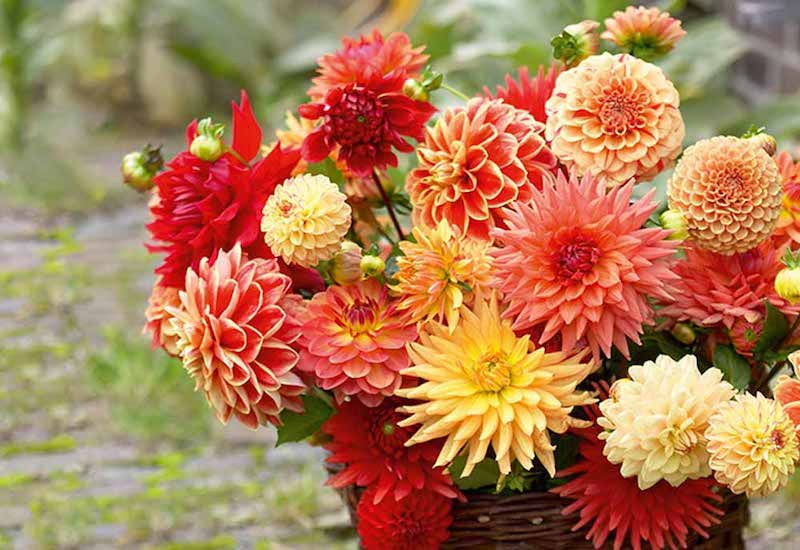Dahlias are fantastic late-summer flowers loved by gardeners across the UK. Ranging in size from huge dinner plates to neat tennis-ball-shaped pom poms, they come in every colour of the rainbow. As tender perennials they need a little TLC, but they’re a real treat at the end of summer when they send forth their dazzling blooms.
Browse our full range of dahlia tubers or get a head start with some quality dahlia plants. And in the meantime, here’s everything you need to know about growing dahlias.
What are dahlias?
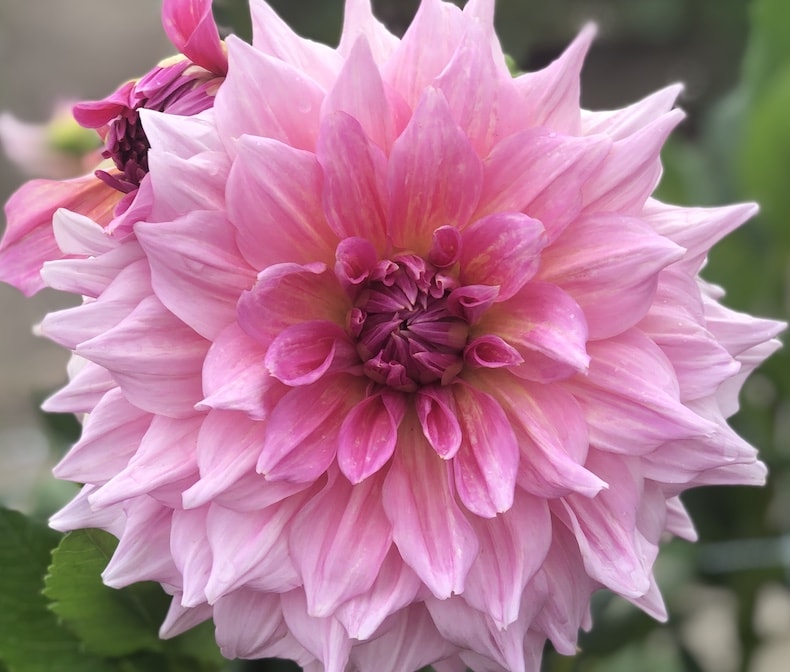
The dahlia is the national flower of Mexico
Image: Dahlia ‘Otto’s Thrill’ from Suttons
Dahlias hail from high altitude hillsides in tropical Central America and Mexico, but in recent years they’ve become a common sight in gardens across the UK. This resurgence in popularity is partly due to the glorious new hybrids available and their excellence as a cut flower.
They have bushy green, sometimes black, foliage which dies back in winter to resprout again in spring. Available in many varieties, dahlias are split into groups by their spectacular flower shapes. Here are the most popular types:
- Anemone: These dahlia flowers have tight ruffled centres surrounded by open single petals. Dahlia ‘Totally Tangerine’ is a fantastic example with a stunning purple hue.
- Cactus: Think large and spiky like the name, these flowers often reach the size of dinner plates. Dahlia ‘Yellow Star’ is a gorgeous yellow example of a cactus dahlia with multiple finger-like petals bursting open like a firework.
- Pom pom: With tight spherical blooms and tubular petals, Dahlia ‘Cornel’ is a lovely caramel coloured example of this type.
- Water Lily: Just like their namesake, these dahlias unfurl with multiple petals opening from a central point. See Dahlia ‘Creme de Cassis’ for a lovely blackcurrant option.
- Single: These pretty dahlias have a single layer of bright petals surrounding an open centre. The best variety for pollinators, Dahlia ‘Mystic Illusion’ is a lovely bright example.
How to grow dahlias from tubers
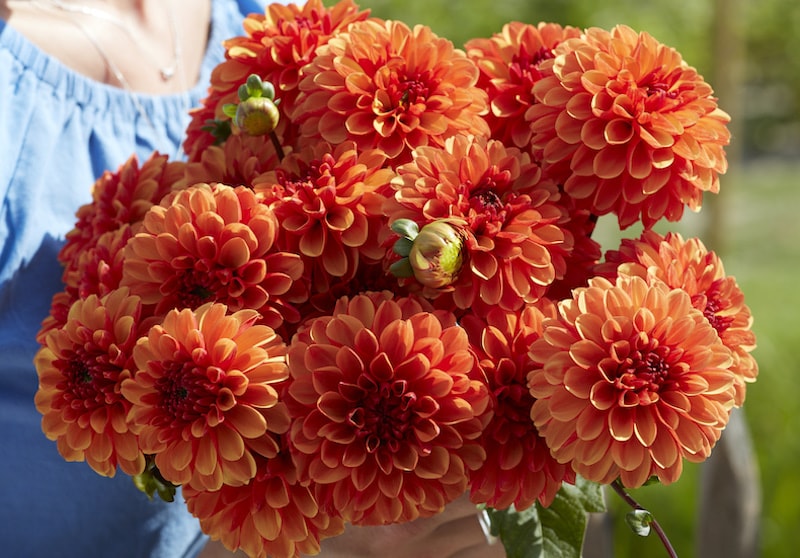
Dahlia ‘American Sunset’ is a fabulous variety to grow
Image: Dahlia ‘American Sunset’ from Suttons
April is the perfect time to pot up your new dahlia tubers. Using a light and sandy compost, bury each tuber with the old stem facing upwards just below the soil surface, giving them a good water to settle the soil. Place the pots in a frost-free greenhouse or sunny sheltered spot to sprout.
Keep your young plants moist as they develop but never allow them to become waterlogged. You’ll also need to shelter them from any late frosts. Your tubers should have developed into healthy, bushy plants by the end of May.
How to grow dahlias from seeds

Bees love open flowered dahlias like ‘Dwarf Cactus Mix’
Image: Dahlia ‘Dwarf Cactus Mix’ seeds from Suttons
Although most people start their dahlias from tubers or buy garden-ready plants, you can also grow them from seeds. Here’s how:
- Start your seeds off early in a propagator or frost-free greenhouse
- Sieve multi-purpose compost to get a fine consistency
- Fill your seed tray
- Water the compost and sprinkle your seeds evenly
- Cover your seeds with a thin layer of compost
- Label each tray with the date and variety
Your seeds should germinate within a few weeks and can be gently transplanted into small individual pots as soon as the first true leaves have developed. Around the end of May, when the threat of frost has passed, begin to harden off your plants by moving them outdoors in the day and back indoors overnight. After a week or two, they should be ready to plant out.
When to plant dahlias outside

Dahlia flowers have wonderful detail and colour
Image: Dahlia ‘Bodacious’ from Suttons
After the last frost date in May, your healthy young plants should be ready to move outside. Whether you’ve raised your own plants from seed, ordered tubers, or bought mature plants, get them in the ground with a sturdy stake for support and plenty of organic matter.
Dig a hole and bury your plant up to the juncture between the stem and root. Give your dahlia a really good water after planting to settle the soil. Slugs and snails love young dahlia shoots, so consider using slug and snail deterrents to protect young plants as they develop.
How to care for dahlias
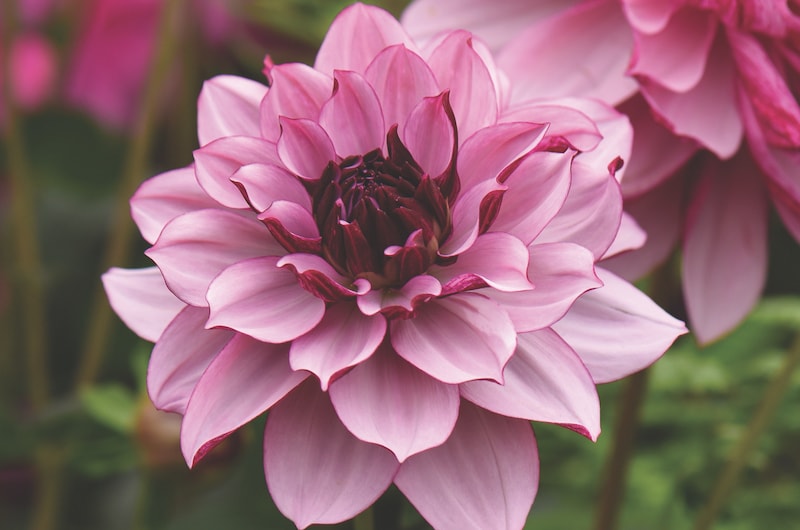
Dahlia ‘Creme de Cassis’ has the most fantastic bicoloured petals
Image: Dahlia ‘Creme de Cassis’ from Suttons/©Visions BV, Netherlands
For a bushy dahlia plant with plenty of flowering side shoots, gently pinch off the growing tip when your dahlia is roughly 20cm tall. Taking it back to the top pair of leaves early in the summer will encourage it to bush out. Keep an eye on wind-rock as your dahlia grows and tie it securely to a sturdy stake to prevent any wind damage to the main stem or roots.
Dahlias appreciate a potash feed every few weeks and a good layer of mulch above the roots to keep them moist. Water your dahlia well every week during the summer and deadhead any spent blooms as they appear to encourage more flowers.
How to overwinter dahlias
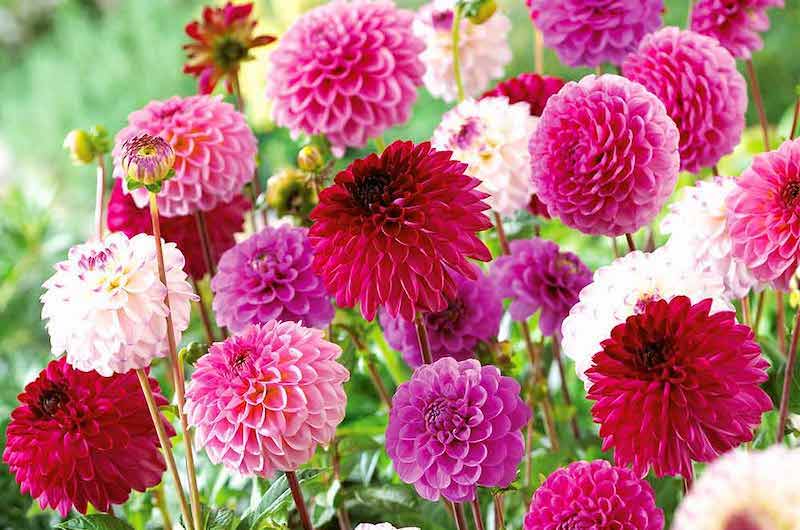
Pom pom dahlias have lovely neat spherical flower heads
©Visions BV, Netherlands
Ideally, you want to lift your dahlia tubers for overwintering around the time of the first frosts in autumn. Cut back the top growth neatly with clean secateurs and use a garden fork to gently lift them, removing most of the soil and smaller roots with gloved hands.
Allow your tubers to dry in trays for a few weeks in a frost-free space like a shed or greenhouse. Once they’re dry, cover the tray with dry sand or compost and store in a cool place over winter. Don’t give them any water or light, they’re fine left in a dark garage or shed.
Alternatively, if you don’t have storage space or live in a frost-free area, simply cut back any top growth and leave the tubers in the ground with a deep covering of mulch.
Inspired to start your dahlias from seed this year? Browse our range of dahlia seeds here. And for more fantastic tricks and tips, see our best expert advice on growing dahlias.
Lead image: Dahlia Tubers – Orange/Salmon Mix from Suttons/©Visions BV, Netherlands
Last Updated on September 15, 2025 by Suttons Horticultural Team

